Admirers of Hayao Miyazaki will find much to love in The Boy and the Heron, which he has said will be his final feature before retiring from film-making at the age of 82. It’s a beautifully crafted piece of work with all the tropes that admirers of Studio Ghibli have come to love over the years.
The film opens with an apocalyptic fire; it’s night, the air raid sirens howl and the skies are filled with flaming fragments. We hear the frantic breathing of a boy, running towards the burning Tokyo hospital where his mother works. It’s 1943, the Pacific War is raging and 12-year-old Mahito Maki is taken by his industrialist father to live in the countryside (much as the girls in Totoro were). His father has a grand estate and introduces his new pregnant wife, Natsuko (pictured below) to his son; Mahito isn’t prepared to accept her even though she’s his late mother’s sister and looks like her.
 Grieving Mahito struggles to fit in at his new school and engineers a head injury to stay home. He attracts the attention of a mysterious heron that lands on the windowsill of his bedroom, much to the bemusement of the gaggle of elderly maids who staff the house. When Natsuko mysteriously disappears, Mahito goes to find her and is soon immersed in a series of visually stunning adventures. A derelict tower built by an eccentric great uncle leads to an alternative world.
Grieving Mahito struggles to fit in at his new school and engineers a head injury to stay home. He attracts the attention of a mysterious heron that lands on the windowsill of his bedroom, much to the bemusement of the gaggle of elderly maids who staff the house. When Natsuko mysteriously disappears, Mahito goes to find her and is soon immersed in a series of visually stunning adventures. A derelict tower built by an eccentric great uncle leads to an alternative world.
There are many magical creatures – not just the heron who harbours a man inside his body and may or may not be the boy’s protector. Voracious pelicans, swirls of smiling white blobs and a flurry of malevolent multi-coloured parakeets all illuminate the screen and hark back to many of the spectacular fantasy sequences from Miyazaki classics like Princess Mononoke, Howl’s Moving Castle and most of all, Spirited Away.
The original Japanese title of The Boy and the Heron is How Do You Live, referencing a 1937 novel about a boy who also lost a parent and was bullied at school, but there seems to be a closer overlap with Miyazaki’s own childhood. The director lost his mother during the war and had a father who manufactured fighter plane components.
Miyazaki teases out themes around mourning and acceptance as Mahito struggles with the challenges thrown at him by the creatures that spring up around him and his own immaturity. Like other Studio Ghibli films, The Boy and the Heron doubtless requires repeated viewings and an understanding of Japanese folklore to fully appreciate Miyazaki’s intentions, but even on a first encounter, it’s a stunning piece of artistry.













Add comment